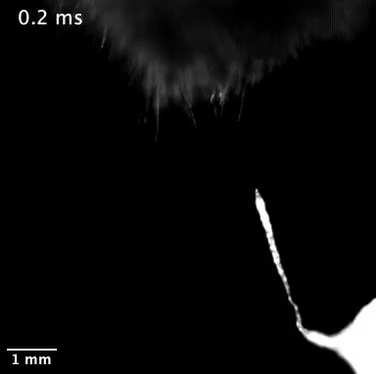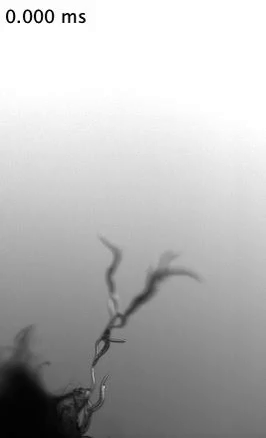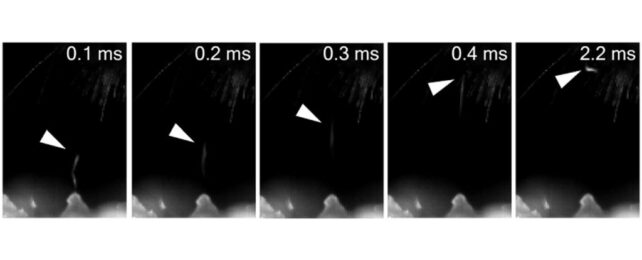To something the size of a human, static electricity is, at most, a hair-raising experience. When you're a tiny nematode, electrical fields are positively uplifting. Literally.
The most famous nematode of all – Caenorhabditis elegans – has been caught using electrical fields to its advantage. The tiny worm can somehow piggyback on electrical fields to jump a surprising distance, across a petri dish, for example, or onto the back of a bumblebee for a ride to a new locale.
It's not entirely clear how the nematodes do this, but thanks to an experiment led by biologist Takuya Chiba of Hokkaido University in Japan, it's now apparent that these tiny animals use electrical fields to disperse far afield into new habitats.
"Pollinators, such as insects and hummingbirds, are known to be electrically charged, and it is believed that pollen is attracted by the electric field formed by the pollinator and the plant," says biophysicist Takuma Sugi of Hiroshima University in Japan, co-senior author on the study.
"However, it was not completely clear whether electric fields are utilized for interactions between different terrestrial animals."
It's been known for some time that C. elegans – one of the most studied organisms in the world – can sense electrical fields and even align their bodies with their negative poles.
But Chiba and his colleagues noticed they were onto something previously unknown when they spotted C. elegans larvae on the undersides of the lids of polystyrene Petri dishes instead of in the agar medium they had been grown in. That's a distance many times the length of the worm's body, which has a maximum length of about a millimeter.

It could be presumed the worms were crawling the long way around, across the agar substrate, up the walls of the petri dish, and across the lid. But cameras set up to record the worms revealed a very different, unexpected behavior: the larvae were leaping the distance.
The researchers suspected something external was contributing to these leaps since the worms' posture barely changed before jumping, and their tails barely moved while they were in the air. It was as though the worms were practically levitating (although levitating at speed) from the substrate to the lid.
There was a clue in the material of the Petri dishes. Worms in polystyrene dishes leaped a lot; those in glass dishes hardly ever did. Polystyrene is an excellent insulator that retains electrical charge; glass, however, does not.
The researchers measured the electrical potential difference between the substrate and lid for both materials. They found that the glass had a difference of almost zero, compared to a significant difference for the polystyrene. This suggested that electrostatic force helps power the worms' leaps.

So, the team set up experiments to investigate. They constructed a simulated dirt substrate and placed an electrode above it. When no electrical field was generated, no C. elegans larvae leaped. In the presence of an electrical field, however, the jumping behavior was rampant. The average jumping speed was 0.86 meters (2.8 feet) per second, which increased as the electrical field intensified.
Next, the researchers experimented with bumblebees. Like many animals, bumblebees can build an electrical charge as they fly and as they rub themselves against pollen-coated parts of a plant. So researchers observed what happened when these bees grew close to the worms.
Sure enough, the worms – which are not parasitic – piled on, likely to catch a ride to disperse through the environment. In some cases, this hitchhiking occurred en masse in columns of up to 80 worms. Scientists knew about this hitchhiking but did not know how the worms got onto flying insects. This research answers that question.
"Worms stand on their tail to reduce the surface energy between their body and the substrate, thus making it easier for themselves to attach to other passing objects," Sugi says. "In a column, one worm lifts multiple worms, and this worm takes off to transfer across the electric field while carrying all the column worms."

We've observed something similar in parasitic nematodes of the species Steinernema carpocapsae: An electrical charge increases the odds that the worms will land on host flying insects. However, the behaviors of the two species are quite different; S. carpocapsae just sort of leap unthinkingly and end up attracted to flying objects with an electrical charge, including water droplets, while C. elegans doesn't leap without the charge.
The physical mechanisms behind C. elegans's superhero leap aren't clear. The researchers found that similar species with mutations that remove their ability to sense electrical fields don't jump as frequently but have not investigated where those genes can be found in C. elegans.
"Further studies on the electric field and the behavior of C. elegans are expected to provide more details on the electrical ethology of microorganisms," the researchers conclude.
The research has been published in Current Biology.
